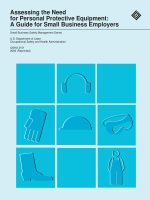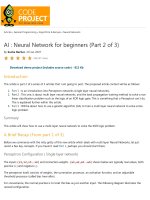Control Engineering - A guide for beginners - Chapter 2 ppsx
Bạn đang xem bản rút gọn của tài liệu. Xem và tải ngay bản đầy đủ của tài liệu tại đây (262.84 KB, 16 trang )
29
JUMO, FAS 525, Edition 02.04
2 The process
2.1 Dynamic action of technical systems
The process is the element of a system which has to be controlled in accordance with the applica-
tion duty. In practice, the process represents either an installation or a manufacturing process
which requires controlling. Normally, the process covers a number of elements within a system.
The input is the manipulating variable y received from the control device. The output is represented
by the process variable x. As well as these two variables there are the disturbances z which affect
the process to some extent, through external influences or process-dependent variations.
An example of a process is a gas-fired furnace (see Fig. 15). At the start of the process is the valve,
which has as its input the manipulating variable of the controller. The valve controls the gas flow to
the burner. The burner produces heat energy by burning the gas, which brings the charge up to a
higher temperature. If the temperature in the charge is measured (process value), this also forms
part of the process. The final component of the process here is the sensor, which has the job of
converting the temperature into an electrical signal. Disturbances here are all the variables in the
process which, when they change, result in a different temperature for the same valve setting.
Example: If the manipulating variable is just large enough to give the required temperature in the
charge, and a disturbance occurs due to a fall in outside ambient temperature, then, if the manipu-
lating variable is not changed, the temperature in the charge will also be lower.
Fig. 15: Input and output variables of a process
When designing a control loop, it is important to know how the process responds when there is a
change in one of the influencing variables mentioned above. On the one hand, it is of interest to
know the new process value reached when stable conditions have been attained, following such
changes. On the other hand, it is also important to find out how the process value varied with time
during the transition to the new steady-state value. A knowledge of the characteristics determined
by the process is essential and can help to avoid difficulties later on, when designing the process.
2 The process
30
JUMO, FAS 525, Edition 02.04
Although processes have many different technical arrangements, they can be broadly categorized
by the following features:
- with and without self-limitation,
- with and without dead time or timing elements,
- linear or non-linear.
In most cases, however, a combination of individual characteristics will be present.
An accurate characterization and detailed knowledge of the process is a prerequisite for the design
of controls and for the optimum solution of a control task. It is not possible to select suitable con-
trollers and adjust their parameters, without knowing exactly how the process behaves. The de-
scription of the dynamic action is important to achieve the objective of control engineering, i.e. to
control the dynamic behavior of technical dynamic systems and to impose a specific transient re-
sponse on the technical system.
Static characteristic
The static behavior of a technical system can be described by considering the output signal in rela-
tion to the input signal. In other words, by determining the value of the output signal for different in-
put signals. With an electrical or electronic system, for instance, a voltage from a voltage source
can be applied to the input, and the corresponding output voltage determined. When considering
the static behavior of control loop elements, it is of no importance how a particular control element
reaches its final state. The only comparison made is limited to the values of the input and output
signals at the end of the stabilization or settling time.
When measuring static characteristics, it is interesting to know, amongst other things, whether the
particular control loop element exhibits a linear behavior, i.e. whether the output variable of the
control element follows the input proportionally. If this is not the case, an attempt is made to deter-
mine the exact functional relationship. Many control loop elements used in practice exhibit a linear
behavior over a limited range. With special regard to the process, this means that when the manip-
ulating variable MV is doubled, the process value PV also doubles; PV increases and decreases
equally with MV.
An example of a transfer element with a linear characteristic is an RC network. The output voltage
U2 follows the applied voltage U1 with a certain dynamic action, but the individual final values are
proportional to the applied voltages (see Fig. 16). This can be expressed by stating that the pro-
cess gain of a linear process is constant, as a change in the input value always results in the same
change in the output value.
However, if we now look at an electrically heated furnace, we find that this is in fact a non-linear
process. From Fig. 16 it is clear that a change in heater power from 500 to 1000W produces a larg-
er temperature increase than a change in power from 2000 to 2500W. Unlike the behavior of an RC
network, the furnace temperature does not increase to the same extent as the power supplied, as
the heat losses due to radiation become more pronounced at higher temperatures. The power
must therefore be increased to compensate for the energy losses. The transfer coefficient or pro-
cess gain of this type of system is not constant, but decreases with increasing process values. This
is covered in more detail in Chapter 2.8.
31
2 The process
JUMO, FAS 525, Edition 02.04
Fig. 16: Linear and non-linear characteristics
Dynamic characteristic
The dynamic response of the process is decisive for characterizing the control loop. The dynamic
characteristic describes the variation in the output signal of the transfer element (the process)
when the input signal varies with time. In theory, it is possible for the output variable to change im-
mediately and to the same extent as the input variable changes. However, in many cases, the sys-
tem responds with a certain delay.
Fig. 17: Step response of a process with self-limitation
Process
y
t
y
z
x
t
z
t
x
2 The process
32
JUMO, FAS 525, Edition 02.04
The simplest way of establishing the behavior of the output signal is to record the variation of the
process value PV with time, after a step change in the manipulating variable MV. This “step re-
sponse” is determined by applying a step change to the input of the process, and recording the
variation of PV with time. The step change need not necessarily be from 0 to 100%; step changes
over smaller ranges can be applied, e.g. from 30 to 50%. The dynamic behavior of processes can
be clearly predicted from this type of step response, which will be discussed in more detail in
Chapter 2.6.
2.2 Processes with self-limitation
Processes with self-limitation respond to a change in the manipulating variable or to a disturbance
by moving to a new stable process value. This type of process can dissipate the energy supplied
and achieve a fresh equilibrium.
A classic example is a furnace where, as the heating power is increased, the temperature rises until
a new equilibrium temperature is reached, at which the heat lost is equal to the heat supplied.
However, in a furnace, it takes some time to achieve the new equilibrium following a step change in
the manipulating variable. In processes without delays, the process value immediately follows the
manipulating variable. The step response of such a process then has the form shown in Fig. 18.
Fig. 18: Process without delay; P process
In this type of process with self-limitation, the process value PV is proportional to the manipulating
variable MV, i.e. PV increases to the same extent as MV. Such processes are often called propor-
tional processes or P processes. The relationship between process value x and manipulating vari-
able y is given by:
∆xK
S
∆y•=
33
2 The process
JUMO, FAS 525, Edition 02.04
The factor K
S
is known as the process gain (transfer coefficient). The relationship will be discussed
in more detail in Chapter 2.8.
Examples of proportional processes are:
- mechanical gearing without slip
- mechanical transmission by lever
- transistor (collector current I
c
follows the base current I
B
with virtually no delay)
2.3 Processes without self-limitation
A process without self-limitation responds to a change in the manipulating variable or to a distur-
bance by a permanent constant change in the process value. This type of process is found in the
course control of an aircraft, where a change in the manipulating variable (rudder deviation) pro-
duces an increase in the process value deviation (course deviation) which is proportional to time. In
other words, the course deviation continually increases with time (see Fig. 19).
Fig. 19: Process without self-limitation; I process
Because of this integrating effect, such processes are also called integral processes or I process-
es. In this type of process, the process value increases proportionally with time as a result of a step
change ∆y in the manipulating variable. If the change in MV is doubled, the process value will also
double after a certain time.
If ∆y is constant, the following relationship applies:
K
IS
is called the transfer coefficient of the process without self-limitation. The process value now
increases proportionally with both the manipulating variable change ∆y, as in a process with self-
limitation, and also with time t.
∆xK
IS
∆yt••=
2 The process
34
JUMO, FAS 525, Edition 02.04
Additional examples of processes without self-limitation are:
- an electric motor driving a threaded spindle
- the liquid level in a tank (see Fig. 20)
Fig. 20: Liquid level in a tank; I process
Probably the best known example of a process without self-limitation is a liquid container with an
inflow and an outflow. The outlet valve, which here represents the disturbance, is assumed to be
closed initially. If the inlet valve is now opened to a fixed position, the liquid level (h) in the container
will rise steadily at a uniform rate with time.
The level in the container rises faster as the inflow rate increases. The water level will continue to
rise until the container overflows. In this case, the process does not self-stabilize. Taking the effect
of outflow into consideration, no new equilibrium is reached after a disturbance (except when in-
flow = outflow), unlike the case of a process with self-limitation.
In general, processes without self-limitation are more difficult to control than those with self-limita-
tion, as they do not stabilize. The reason is, that following an overshoot due to an excessive
change in MV by the controller, the excessive PV cannot be reduced by process self-limitation.
Take a case where the rudder is moved too far when making a course adjustment, this can only be
corrected by applying an opposing MV. An excessive change in MV could cause the process value
to swing back below the desired setpoint, which is why control of such a process is more difficult.
35
2 The process
JUMO, FAS 525, Edition 02.04
2.4 Processes with dead time
In processes with a pure dead time the process only responds after a certain time has elapsed, the
dead time T
t
. Similarly, the response of the process value is delayed when the manipulating vari-
able changes back (see Fig. 21).
Fig. 21: Process with dead time; T
t
process
A typical example here is a belt conveyor, where there is a certain time delay before a change in the
chute feed rate is recorded at the measurement location (see Fig. 22).
Systems like this, which are affected by a dead time, are called T
t
processes. The relationship be-
tween process value x and manipulating variable y is as follows:
but delayed by the dead time T
t
.
∆xK
S
∆y•=
2 The process
36
JUMO, FAS 525, Edition 02.04
Fig. 22: Example of a process with dead time; belt conveyor
Another example is a pressure control system with long gas lines. Because the gas is compress-
ible, it takes a certain time for a pressure change to propagate. By contrast, liquid-filled pipelines
have virtually no dead time, since any pressure change is propagated at the speed of sound. Relay
switching times and actuator stroke times also introduce delays, so that such elements in the con-
trol loop frequently give rise to dead times in the process.
Dead times pose a serious problem in control engineering, since the effect of a change in manipu-
lating variable is only reproduced in the process variable after the dead time has elapsed. If the
change in manipulating variable was too large, there is a time interval before this is noticed and
acted on by reducing the manipulating variable. However, if this process input is then too small, it
has to be increased once more, again after the dead time has elapsed, and so the sequence con-
tinues. Systems affected by dead time always have a tendency to oscillate. In addition, dead times
can only really be compensated for by the use of very complex controller designs. When designing
and constructing a process, it is very important that dead times are avoided wherever possible. In
many cases this can be achieved by a suitable arrangement of the sensor and the application point
of the manipulating variable. Thermal and flow resistances should be avoided or kept to a mini-
mum. Always try to mount the sensor at a suitable location in the process where it will read the av-
erage value of the process conditions, avoiding dead spaces, thermal resistances, friction etc.
Dead times can occur in processes with and without self-limitation.
37
2 The process
JUMO, FAS 525, Edition 02.04
2.5 Processes with delay
In many processes there is a delay in propagation of a disturbance, even when no dead time is
present. Unlike the case explained above, the change does not appear to its full extent after the
dead time has elapsed, but varies continuously, even following a step change in the disturbing in-
fluence.
Continuing with the example of a furnace, and looking closely at the internal temperature propaga-
tion:
If there is a sudden change in heating power, the energy must first of all heat up the heating ele-
ment, the furnace material and other parts of the furnace until a probe inside the furnace can regis-
ter the change in temperature. The temperature therefore rises slowly at first until the temperature
disturbance has propagated and there is a constant flow of energy. The temperature then contin-
ues to rise. Over a period of time the temperature of the heating element and the probe come clos-
er and closer together; the temperature increases at a lower rate and approaches a final value (see
Fig. 23).
Fig. 23: Processes with delay
2 The process
38
JUMO, FAS 525, Edition 02.04
As an analogy, consider two pressure vessels which are connected by a throttle valve. In this case,
the air must flow into the first vessel initially, and build up a pressure there, before it can flow into
the second vessel. Eventually, the pressure in the first vessel reaches the supply pressure, and no
more air can flow into it. As the pressures in the two vessels slowly come into line with each other,
the pressure equalization rate between the two vessels becomes slower and slower, i.e. the pres-
sure in the second vessel rises more and more slowly. Following a step change in the manipulating
variable (in this case the supply line pressure) the process value (here the pressure in the second
vessel) will take the following course: a very slow rise to begin with until a certain pressure has built
up in the first vessel, followed by a steady rise and then finally an asymptotic or gradual approach
to the final value.
The transfer function of this type of system is determined by the number of energy stores available
which are separated from each other by resistances. This concept can also be used when referring
to the number of delays or time elements present in a process.
Such processes can be represented mathematically by an equation (exponential function) which
has an exponential term for each energy store. Because of this relationship, these processes are
designated as first-order, second-order, third-order processes, and so on.
The systems may be processes with or without self-limitation, which can also be affected by dead
time.
2.5.1 Processes with one delay (first-order processes)
In a process with one delay, i.e. with one available energy store, a step change in MV causes the
PV to change immediately without delay and at a certain initial rate of change: PV then approaches
the final value more and more slowly (see Fig. 24).
Fig. 24: First-order process; PT
1
process
39
2 The process
JUMO, FAS 525, Edition 02.04
For a step change ∆y the relationship is as follows:
The term in brackets shows that a step change in MV does not produce a corresponding immedi-
ate change in PV. Instead PV slowly approaches the final value in a characteristic manner. As the
time t increases (large value of t/T), the value of the expression in the brackets tends towards 1, so
that for the final value, ∆x = K
S
• ∆y.
As shown in Fig. 24, after a time t = T (time constant), the PV has reached 63% of the final value.
After a time t = 5 T, the PV has almost reached 100% of the final value.
Such processes are also referred to as T
1
processes. If it is a process with self-limitation, it is re-
ferred to as a PT
1
process; a process without self-limitation is an IT
1
process. Processes with one
delay (first-order) occur very frequently. Examples are:
- heating and cooling of a hot water tank
- filling a container with air or gas via a throttle valve or a small bore pipe
2.5.2 Processes with two delays (second-order processes)
In a process with two delays there must be two storage elements, connected together by a resis-
tance. Such processes can be characterized by specifying the transfer coefficient K
S
and the time
constants T
1
and T
2
. Here, in contrast to a first order process, the step response of the process
value starts with a horizontal phase and also has a point of inflection (see Fig. 25).
The course of the step response cannot be drawn by simply combining T
1
and T
2
. For a step
change ∆y and for T
1
not equal to T
2
, the relationship is as follows:
Example:
A typical example of a first-order
process is the charge or discharge
of a capacitor through a resistor.
The plot of the process variable
(capacitor voltage) follows a typi-
cal exponential function.
Uin
Uout
R
Uout = Uin (1 - e )
-t
RC
∆xK
S
∆y1e
-t
T
–
⎝⎠
⎜⎟
⎜⎟
⎛⎞
••=
∆xK
S
∆y1
T
1
T
1
T
2
–
e
t–
T
1
+
T
2
T
1
T
2
–
e
t–
T
2
–
⎝⎠
⎜⎟
⎜⎟
⎜⎟
⎛⎞
••=
2 The process
40
JUMO, FAS 525, Edition 02.04
Fig. 25: Second-order process; PT
2
process
Such a process is normally called a PT
2
process. As already discussed, second-order processes
always have a point of inflection, where the radius of curvature changes from a left-hand to a right-
hand curve. First-order processes do not have this point of inflection.
Typical examples of this type of action are:
- filling two containers in series with air or gas through restrictors (see Fig. 23)
- charging up two RC networks in series
- temperature rise in a heated hot-water tank, where the thermometer is mounted in a pocket.
41
2 The process
JUMO, FAS 525, Edition 02.04
2.5.3 Processes with several delays (higher-order processes)
If there are more than two storage elements, the process has a correspondingly higher order.
Interestingly enough, the transfer function characteristic of a higher-order process shows very little
change from that of a second-order process. The rise of the curve does, however, become increas-
ingly steeper and more delayed, until, with an infinite number of time delay elements, it approaches
a pure dead time (see Fig. 26).
The order of a process is an important characteristic, particularly when describing it mathematical-
ly. In practice, almost every process is made up of a large number of widely differing energy stor-
age elements, such as protective fittings, filling materials for temperature probes, dead spaces in
manometers, etc. As a result, it is quite impossible to give an accurate mathematical description of
an actual process.
Fig. 26: Processes with several delays
In practice, the exact order of the process is not as important as might appear at first glance. Of
much greater significance are the longest delay times, which determine the nature of the process.
As the order of the process increases, it becomes more and more difficult to control, since it ap-
proximates more and more to a system with dead time. A combination with a pure dead time is
also possible, when the controllability deteriorates even more. Controllability is improved when
there are significant differences between the time constants of the individual process elements.
The worst case occurs when the time constants have the same value.
2.6 Recording the step response
The step response of a process, i.e. the course of the process value PV following a step change in
manipulating variable MV can be characterized by two time values:
-the delay time T
u,
and the
- response time T
g
If these times are known, a quick estimate of the controllability of a process can be made, and the
control parameters determined in a simple way, as explained later. The order of the process is ig-
nored when using this approach, where it is assumed that any process is made up of a dead time
T
u
and a first-order process with a time constant T
g
.
To determine such a transfer function and the resulting delay and response times, a recorder is
connected to the transducer (sensor) and the manipulating variable (e.g. heating current) changed
suddenly. Obviously, the change in MV should be limited to a value such that the new setpoint can
be reached without damaging the system. The course of the process value is recorded, a tangent
is drawn to the curve at the point of inflection, and T
u
and T
g
are determined as shown in Fig. 27.
y
t
∆y
t
0
infinite order
Process value
t
x
t
0
2 The process
42
JUMO, FAS 525, Edition 02.04
Fig. 27: Determining the delay time and response time
The ratio of delay time to response time gives information about the character of the process and
its controllability:
T
g
/T
u
more than 10: process easy to control
T
g
/T
u
between 10 and 3: process can be controlled
T
g
/T
u
less than 3: process difficult to control
As the ratio of response time T
g
to delay time T
u
reduces, there is an increasing delay before the
change in manipulating variable is communicated to the controller, and the controllability is pro-
gressively reduced. As explained in Chapter 2.5.3, a low T
g
/T
u
ratio corresponds to a steep gradi-
ent on the graph, representing a higher-order process which is difficult to control because of its
tendency to overshoot.
Fast processes with T
g
/T
u
less than 3 are comparatively rare in furnaces, for example, since the
temperature disturbance propagates relatively slowly and continuously through the furnace materi-
al. One exception is the type of furnace where the heating acts directly on the charge. The situation
is quite different with pressure control: opening an air-lock can lead to a sudden drop in pressure,
to which the controller must respond with an equally fast increase in supply pressure. Pressure
equalization in the system takes place just as quickly, so that the entire control process is complet-
ed within a short space of time. In these processes the dead times are long in relation to the delay
times. Certain chemical processes (reactions, neutralization) can sometimes proceed very quickly.
As well as the delay and response times, another important characteristic of the process can be
determined, the maximum rate of rise V
max
. It is obtained from the slope of the tangent at the point
of inflection (see Fig. 27):
y
t
Dx
t
x
Dt
inflection point
inflection tangent
T
u
T
g
Dy
43
2 The process
JUMO, FAS 525, Edition 02.04
As shown later in the section on optimization, the maximum rate of rise is also referred to when
setting control parameters.
DIN Specification 19 226 refers to the start-up value A instead of the rate of rise. This start-up val-
ue is the reciprocal of the maximum rate of rise of the process value PV for a sudden change in the
manipulating variable from 0 — 100%:
2.7 Characteristic values of processes
The delay times and response times (standard values) of some typical processes are shown in
Table 2 below.
Table 2: Delay times and response times (standard values) for some processes
The values given in the table should be taken as average values and serve only as a rough guide.
For practical applications, the values of delay time and response time should be determined by
carrying out a step response test.
2.8 Transfer coefficient and working point
Previous sections have dealt mainly with the dynamic characteristic of the process (course of the
step response), i.e. its behavior with respect to time. Chapter 2.1 has already mentioned the static
characteristic, and described the final values for various manipulating variables. No account is tak-
en of changes in the process value with respect to time.
The transfer coefficient is given by the ratio of output to input value, in this case the ratio of the
change in process variable to the change in manipulating variable.
Process
variable
Type of process Delay time T
u
Response time T
g
Temperature small electrically-heated oven
large electrically-heated furnace
large gas-fired reheating furnace
autoclave
high-pressure autoclave
injection molding machine
extruder
packaging machine
0.5 — 1 min
1 — 5 min
0.2 — 5 min
0.5 — 0.7 min
12 —15 min
0.5 — 3 min
1 — 6 min
0.5 — 4 min
5 — 15min
10 — 20min
3 — 60min
10 — 20min
200 — 300min
3 — 300min
5 — 60min
3 — 40min
Pressure drum boiler, gas or oil-fired
drum boiler, solid fuel-fired
0sec
0—2min
150sec
2.5 — 5min
Flow gas pipelines
liquid pipelines
0—5sec
0sec
0.2 — 10sec
0sec
V
max
change in process variable
unit time
∆x
∆t
==
A
1
V
max
=
K
S
change in process variable
change in manipulating variable
∆x
∆y
==
2 The process
44
JUMO, FAS 525, Edition 02.04
The transfer coefficient K
S
is also called the process gain.
In many cases the process gain K
S
is not constant over the entire range of the process variable, as
the following case will explain: in a furnace, a small increase in heating power is sufficient to pro-
duce a large increase in temperature at the lower end of the temperature range; at the upper end of
the temperature range, however, a much larger change in energy flow is required to achieve the
same effect (see Fig. 28).
Fig. 28: Process gain and working point
The reason for this is that the furnace used in the example represents a non-linear process. In ad-
dition to temperature processes, such processes also include processes where the friction is pro-
portional to speed, relationships between motor power and speed, etc.
The delay time and response times in non-linear processes also depend on the working point. Pro-
cess gain K
S
, delay time, response time and other such values must be referred to a working point,
i.e. to a pair of values of MV and PV, at which they have been evaluated. In general, they are not
valid for other working points; in non-linear processes, a new set of values must be determined for
each different working point, since the controller setting depends on the process parameters. In
such processes the action of the controller is only optimized at the working point of the process for
which the values were evaluated. If this is changed, for example, if a different process temperature
is required, the controller has to be re-tuned to achieve optimum control.
Generally, the working point should lie in the range from middle to upper third of the transfer func-
tion at full power. A working point in the lower third is less satisfactory, because of the large excess
power. Although the desired value (setpoint) is reached more rapidly in this case, the controllability
is made worse. A working point in the upper part of the characteristic is also unsatisfactory, due to
the lack of reserve power and resultant slow stabilization, and is also unsatisfactory from the point
of view of disturbances.
Temperature °C
300
200
100
05 10 15
Heating power kW
WP1: K
K depends on the working point
AP1
AP2
Dy
Dy
Dx
Dx
WP: working point
ð
=
D
D
x
y
==20
WP2: K
=
D
D
x
y
==6
S
S
S
30 °C
5 kW
°C
kW
100 °C
5 kW
°C
kW







![drupal 7 primer [electronic resource] creating cms-based websites a guide for beginners](https://media.store123doc.com/images/document/14/y/nl/medium_nlq1401353154.jpg)
![freebsd device drivers [electronic resource] a guide for the intrepid](https://media.store123doc.com/images/document/14/y/kb/medium_kbo1401382568.jpg)
![the mobile frontier [electronic resource] a guide for designing mobile experiences](https://media.store123doc.com/images/document/14/y/qr/medium_qrw1401383749.jpg)